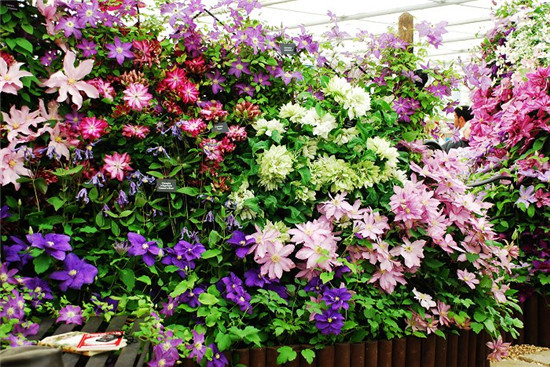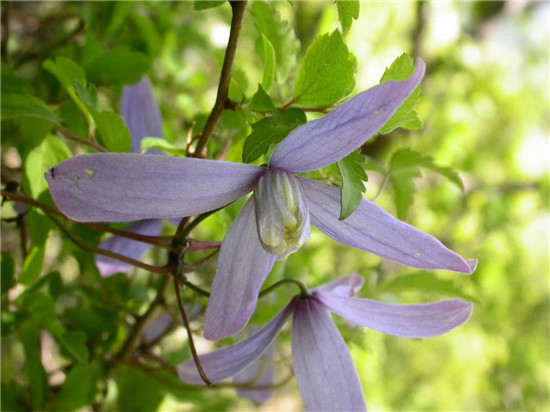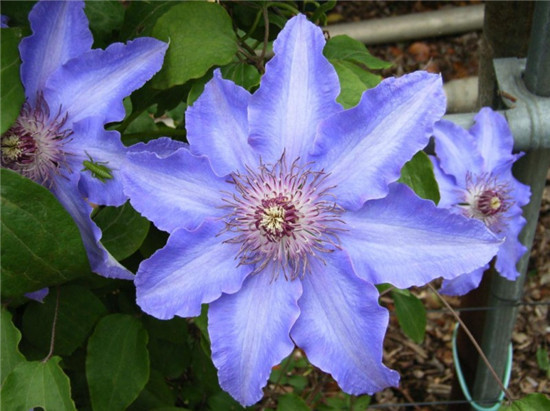Cultivation methods of Clematis
Many people say clematis is a very difficult plant, in fact, it is very easy to plant, let's take a look at the next clematis planting method!

Clematis for Ranunculaceae (Ranunculaceae), Clematis perennial herbs or woody vines. Plant height: about 3-6 m. Tendrils slender, up to four meters Xu, rich toughness, all have sparse short hair. Leaves opposite, stipitate, simple or 1-or 2-ternately compound, petiole can curl; leaflets ovate or ovate-lanceolate, entire, or 2-3-notched. Flowers solitary or panicle, campanulate, urn-shaped or whorled, pedunculated from sepals, 6-12 cm long, middle part bearing opposite bracts; pedicel apex large white flower, flower diam.: 2.5-6 cm; calyx 4-6, ovate, acute, margin slightly undulate, central longitudinal vein with three thick longitudinal veins, outer central longitudinal vein purple, and short hairs; petals absent or replaced by pseudoandroecium. Stamens numerous, often metamorphosed, filaments flattened and enlarged, dark purple; pistils also numerous, styles with filiform hairs or absent. Generally not fruit, only stamens can not be abnormal fruit, achenes gathered into a head shape and with long tail hair. Flowering: May-July.

Clematis for the substrate requirements are not high do not force everyone to use soilless substrate planting, soil can also be planted out of a very good effect, the premise is that the drainage of the substrate must be good, avoid sticky heavy soil, some sticky heavy soil must be improved, mixed with some tiles, tile fragments, perlite, foam particles and so on to increase the drainage of the substrate is very important.
This is especially important for the growth of clematis, clematis actually has a certain drought tolerance, long-term substrate moisture will bring a lot of potential hidden dangers to clematis disease, in addition to the substrate potted when adding drainage layer at the bottom of the pot is also very important, filling at least 5cm large-diameter ceramsite or brick tile is necessary.
Culture method of clematis
1, soil: like fertile, good drainage alkaline loam, avoid water or summer drought and can not retain water soil.
2. Watering: early resistance and fear of waterlogging. Due to high temperature and humidity in plum rain season, it is easy to die, so keep the basin soil moist during the growing season. Avoid excessive watering, otherwise the roots will rot easily.

3, sunshine: potted clematis from autumn to early spring of the second year placed in full light cultivation, do not need shade, after entering the summer strong light, will lead to clematis leaves aging yellow, poor growth, need to be properly shaded.
4, temperature: strong adaptability, cold resistance, can withstand-20 low temperature.
5. Fertilization: The requirements for fertilizer are not high, and liquid fertilizer can be applied once every half month in the peak growth period.
6. Pest: Clematis has strong pest resistance. Serious pest damage is rare. Diseases include blight, which may occur especially in summer when the rain clears, when the temperature rises sharply, the branches suddenly wither, and often germinate in autumn or spring. Others have powdery mildew (damage leaves or flowers), virus disease (leaves have yellow spots, flower deformity), etc., sprayed with 10% antibacterial agent 401 acetic acid solution 1000 times. Insect pests are red spiders, thorn moth harm, with 50% fenitrothion EC 1000 times spray kill.

The above is what I summarized for you Clematis cultivation method of the entire content, I hope this article can help you. Please continue to pay attention to us.
Related
- Wuhan Hospital Iron Tree Blooming Result Was Instantly Frightened by the Gardener Master
- Which variety of camellia is the most fragrant and best? Which one do you like best?
- What is the small blue coat, the breeding methods and matters needing attention of the succulent plant
- Dormancy time and maintenance management of succulent plants during dormancy
- Minas succulent how to raise, Minas succulent plant pictures
- What are the varieties of winter succulent plants
- How to raise succulent plants in twelve rolls? let's take a look at some experience of breeding twelve rolls.
- Attention should be paid to water control for succulent plants during dormant period (winter and summer)
- Watering experience of twelve rolls of succulent plants
- Techniques for fertilizing succulent plants. An article will let you know how to fertilize succulent plants.



